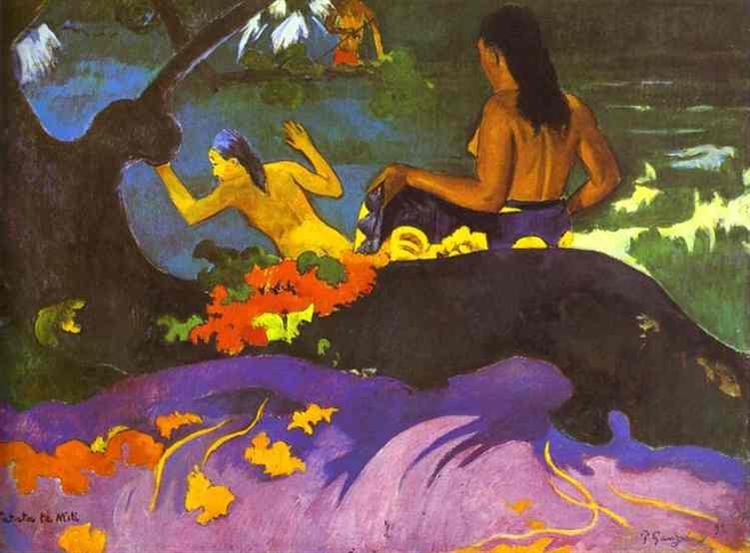Description
Paul Gauguin’s painting “By The Sea” – 1892 is a work that encapsulates the transition between romantic admiration for nature and exploration of everyday life in its more structured context. Executed in Tahiti, where the artist had sought to escape Parisian life, this work displays an amalgamation of Gauguin’s lively colour palette and a distinctive approach to depicting the human figure, which has become characteristic of his style.
The composition of the work presents a clear diagonal that extends from the foreground, where a warm and vibrant blue sea is found at the bottom, ascending towards a background that fades into soft shades of green and brown. The compositional structure directs the viewer's gaze towards the lush nature and serenity of the surroundings, inviting an almost meditative contemplation.
In the foreground, the figure of a woman is immersed in contemplation of the landscape, emphasizing the spiritual connection that Gauguin aspired to convey between humans and their environment. The woman, dressed in a sarong that reinforces the Polynesian atmosphere, seems lost in thought. Her almost introspective attitude reflects a sense of belonging to a place that is both physical and cultural. The use of color also plays a crucial role in the setting of the work; the vibrant shades of blue and green contrast noticeably with the more muted earthly colors, so that the human figure seems to stand out as an element of both balance and diversity in the scene.
The colours highlight not only the landscape, but also the vibrancy of Tahitian culture, which Gauguin was fascinated by. His rich, textured palette departs from Impressionist conventions, opting for a more symbolic than descriptive use of colour, seeking to communicate emotion through a personal and subjective interpretation of nature. This characteristic is a hallmark of his post-impressionist style, where painting becomes a vehicle for internal expression and emotion.
Furthermore, By the Sea falls within a series of works that Gauguin created during his time in Tahiti, where he made a conscious effort to distance himself from European influences and explore what he perceived as authentic life. His work at this stage of his career is often interpolated with a sense of idealization of indigenous culture, which becomes the background for his pictorial narrative. Similar works such as Men’s Day and The Beauty of Life also portray this relationship between humans and their natural environment, a recurring theme that Gauguin adopts to explore his own search for meaning.
Gauguin’s legacy is marked by this interplay between form, color and figure, challenging traditional artistic representation with an approach that prioritizes emotional subjectivity and reflexivity in the face of the landscape. “By the Sea” not only establishes itself as a roller within his artistic corpus, but also as a window into the psychology and philosophy of an artist who questioned, through creation, the role of the human being in the vast canvas of nature. In this work, Gauguin managed to capture not only an instant, but a profound dialogue between the human being, his culture, and the natural elements that surround him.
KUADROS ©, a famous painting on your wall.
Hand-made oil painting reproductions, with the quality of professional artists and the distinctive seal of KUADROS ©.
Painting reproduction service with satisfaction guarantee. If you are not completely satisfied with the replica of your painting, we will refund 100% of your money.

